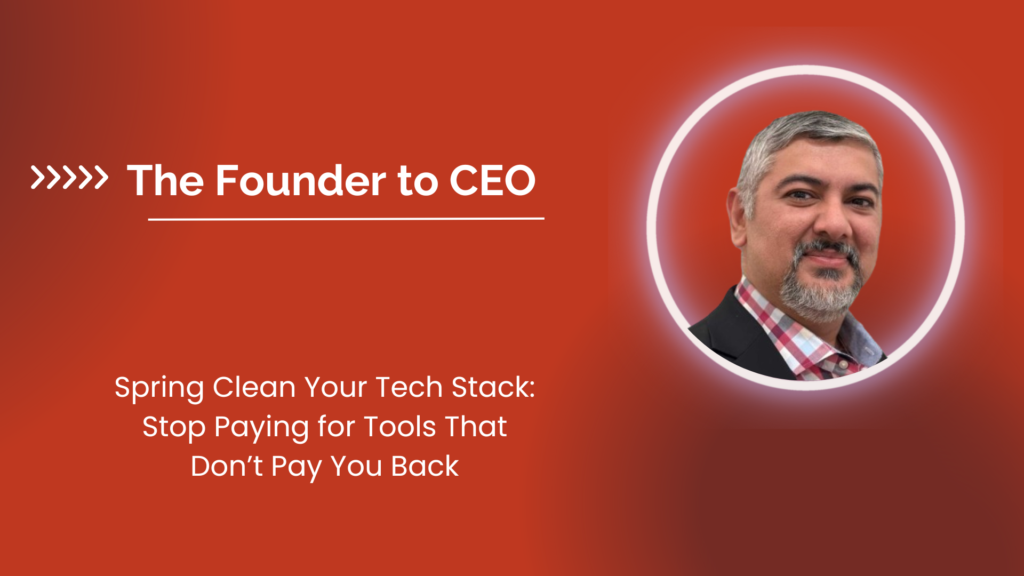Is your tech stack is quietly bleeding you dry?
That $49/month tool you forgot you had.
That dashboard that’s all sizzle, no steak.
That “lifetime deal” gathering dust.
It’s not just wasted money—it’s wasted mental space.
Founders and entrepreneurs, your tools should feel like an extension of your team—sharp, efficient, and easy to train. But for many, their stack has become bloated, redundant, and misaligned with where the business is going.
Today, I’m going to walk you through how to spring clean your tech stack like a pro—with the same mindset shift I coach founders on when they’re overwhelmed by bloat and underwhelmed by results.
STEP 1: Audit With Brutal Honesty—Not Sentimentality
Let’s be real: some of the tools in your stack were perfect… for the company you were last year.
But business is about evolution, not nostalgia. Don’t keep a tool just because you “used to like it.”
Coaching Moment:
If you wouldn’t hire this software again today, why are you still paying its salary?
Action Step:
Export your credit card statement for the last 90 days. Create a spreadsheet and list every recurring software expense. Want to make it easier? Futureproof will organize your subscriptions for you like Rocket Money for your personal finance. (Get on the waitlist)
Next to each, add:
- Usage frequency (daily, weekly, monthly, never)
- Team feedback (Do they love it? Loathe it?)
- Business-critical or not? (Could you operate for a week without it?)
Be ruthless. Emotion is expensive.
STEP 2: Consolidate Like a CEO, Not a Hobbyist
You don’t need 5 different tools that all do the same thing. You need one tool that does it well.
Think like an operator, not a collector. Avoid the bloat that comes with the hotdogs and buns trap. That one more feature becomes expensive.
Coaching Moment:
Every extra platform is another tab open in your brain.
Action Step:
Look for overlapping features.
Example:
- Using Mailchimp for newsletters, Kit for funnels, and Typeform for lead capture? Pick one that can handle all three.
- Got Slack, Discord, and WhatsApp groups for your team? Standardize on one and move.
The goal isn’t fewer tools—it’s fewer headaches.
STEP 3: Upgrade for Scale—Without Breaking the Bank
Too many founders are either overpaying for “pro” tiers they don’t use… or under-investing in tools that would unlock growth.
Coaching Moment:
Ask: Does this tool multiply my time, speed up decisions, or make my team smarter?
Action Step:
For each tool that passed your audit, assess:
- Does this support where we’re headed in 6-12 months?
- Is there a more cost-effective tool that does this better?
- Could we renegotiate pricing or move to annual to save? Only consider annual if you are ready to double down on that tool.
Bonus: Email support and ask for a discount. Never hurts to try.
STEP 4: Empower Your Team to Own the Stack
You shouldn’t be the only one who knows what tools you’re using or how they work.
Coaching Moment:
A tool unused by your team is just a shiny object.
Adoption is everything.
Action Step:
Create a living internal “tool manual.”
List:
- What each tool is for
- Who owns it
- When it was last reviewed
- Links to SOPs or training videos
Then—hold a quarterly Tech Stack Review meeting. Make it part of your operational rhythm.
STEP 5: Implement a “One In, One Out” Rule
Tempted to try the latest AI scheduling tool? Great. But if it comes in, something else goes.
Coaching Moment:
Clarity is a function of constraint.
Your stack should feel like a scalpel, not a Swiss army knife.
Action Step:
Make tool additions a strategic decision, not an impulse buy. Evaluate based on:
- ROI potential
- Team adoption likelihood
- Simplicity it creates
Make new tools earn their place at the table.
Final Reflection
The tools you use should serve your business—not slow it down.
Spring cleaning your stack isn’t just a cost-saving move—it’s a clarity upgrade. It’s a commitment to operating lean, moving fast, and thinking like a CEO instead of a tool junkie.
The best part?
You don’t need 100 tools.
You need the right 10 (or maybe 5).


